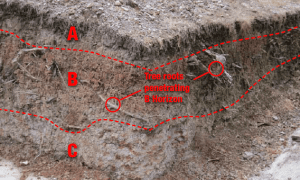Trees require an adequate supply of uncompacted, well-aerated, and moist soil in order to thrive. These conditions enable tree roots to obtain all the essential elements they require for healthy growth – nutrients, oxygen, and water. These soil circumstances however are often unavailable in built urban areas. In this article, we provide a soil quality definition and explain the soil requirements of urban trees.
Soil is the uppermost layer of the earth’s crust and is the medium in which trees and other plants grow and spread their roots. Soil is comprised of finely ground rock particles and materials such as sand, silt, clay, and gravel; with voids between particles containing air and water.
Soil type usually refers to the different sizes of mineral particles in a particular sample. Each size plays a significantly different role. For example, sand represents the largest particles and determines aeration and drainage characteristics, whereas sub-microscopic clay particles are chemically acted binding with plant nutrients and water. The ratio of these particle sizes determines soil type: loam, clay, clay-loam, silt-loam, and so on.
Sandy soils have very large particles allowing plant roots, water, and air to move freely. Whereas clay particles are very small and pack together tightly, leaving little room for nutrients and root growth.
Nutrients
Seventeen essential soil nutrients have been identified. While carbon and oxygen are absorbed from the air, other nutrients such as water are obtained from the soil and absorbed by the tree’s roots. Nutrients consist of calcium, sulphur, and magnesium (amongst a range of other trace elements), although the primary nutrients are:
- Nitrogen (for healthy stem and leaf growth)
- Phosphorus (for root growth)
- Potassium (for overall plant health – especially the immune system)
Organic Matter
In addition to soil’s mineral composition, organic material also plays a critical role in soil fertility and characteristics for plant life. Organic matter improves sandy soil by retaining water and alters clay soil to make it more permeable, allowing water, air, and roots to penetrate.
Soils change in composition and appearance with depth creating what is known as a soil profile. Soil profiles typically have a top layer of decaying organic matter formed by fallen leaves and other debris deposited by plants. This layer also called the ‘O horizon’. Below the organic matter is topsoil (or ‘A horizon’) which can range in depth from a few inches to several feet. This layer consists of decomposed organic matter and minerals, and is usually dark brown or reddish brown in color. This layer is where most tree roots concentrate.
Under the topsoil is subsoil (‘B horizon’) which generally lacks organic matter and therefore has poorer nutritional value. If oxygen levels are sufficient and drainage is adequate, tree roots can penetrate into this layer.
Below the soil layers lies the parent material (‘C horizon’), which is the main source of soil. This material can be transitional, heavy clay, or soft stone. Organic matter and weathering usually do not affect this layer.

Exposed soil profiles and construction sites often show the typical compositions as described above
Cation Exchange
Nutrient uptake in the soil is achieved by cation – positively charged ion – exchange. Fibrous roots pump hydrogen ions (H+) into the soil which displace cations attached to negatively charged soil particles, making the cations available for uptake by the root. Roots, and specifically fibrous roots, are the most important organ for the uptake of nutrients.
In our next article, we talk about the fundamental conflict of maximizing rootable soil volume and allowing for nutrients in the soil, while maintaining structural integrity for paved surfaces.
